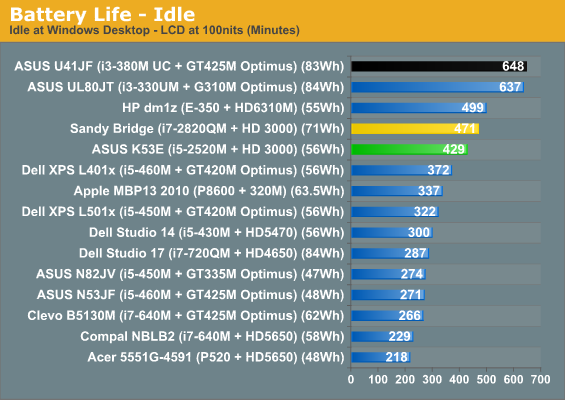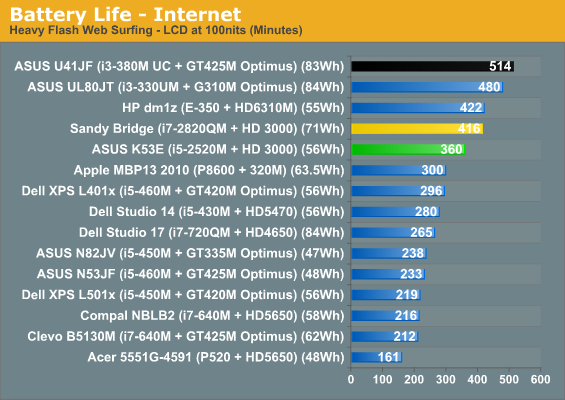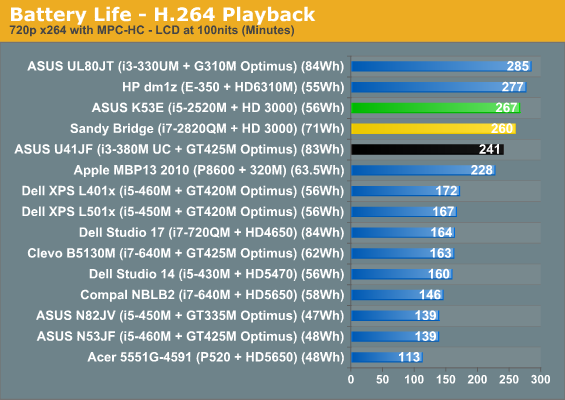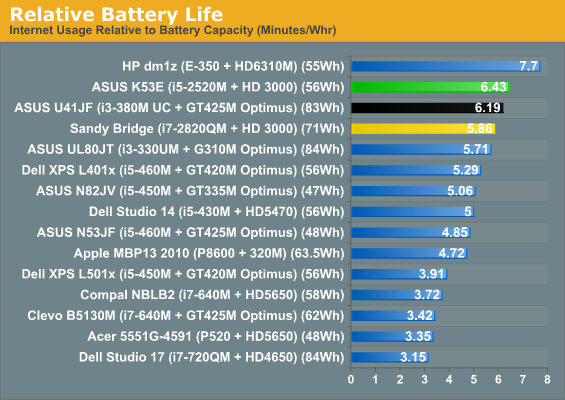ASUS K53E: Testing Dual-Core Sandy Bridge
by Jarred Walton on April 8, 2011 1:00 AM EST- Posted in
- Laptops
- Intel
- Sandy Bridge
- Asus
Battery Life: Minor and Major Improvements
As mentioned earlier, ASUS finally moved to something slightly higher capacity than the 48Wh batteries we’ve seen in so many entry-level notebooks. The result is better battery life, but compared to Arrandale it’s not a huge change in two of our tests. The third test is H.264 playback, and that shows a large increase in battery life. We’ve got the same laptops that we used in our application tests for these charts, but if you want more comparison points we suggest checking out Mobile Bench, where we have results for every laptop we’ve tested in the past year. For example, here’s how the K53E stacks up to one of the few Arrandale-only laptops we’ve tested, the Dell Latitude E6410.




The ASUS K53E places near the top of our battery life charts, with over seven hours of idle battery life, six hours of Internet surfing, and almost 4.5 hours of H.264 video playback. There’s still a sizeable gap between the K53E and laptops like the U41JF, but that’s more a case of battery capacity than efficiency. With a similar size battery capacity (and a much smaller LCD), HP’s dm1z does last over an hour more in the idle and Internet tests. H.264 content is a place where Sandy Bridge excels, however, and with only a 10 minute difference between the 11.6”-screen HP dm1z and the 15.6”-screen ASUS K53E it’s pretty clear that’s one metric where SNB is more efficient. Looking at relative battery life (i.e. true power efficiency), the K53E is only bested by Brazos (and Atom and CULV) in the Internet test. Even the U41JF can’t match the K53E for efficiency, despite underclocking the i3-380M to 700-900MHz (instead of the normal 933-1200MHz) and having a smaller 14” LCD.
For other battery life tests, the K53E lasted just 73 to 83 minutes in simulated gaming (looping 3DMark06/03, respectively), so at heavy loads SNB clearly isn’t a panacea. Setting the LCD to 100% brightness (instead of 50%, which corresponds with 100nits), idle battery life drops 10%. Put another way, the LCD uses an extra 0.87W at 205nits. That’s a very low figure for a 15.6” LCD, but then the maximum brightness isn’t very impressive and as we’ll see shortly, the LCD is otherwise a complete disappointment. Calculated power draw at idle running on battery power is just 7.91W, which used to be Atom territory (though the ASUS Eee PC 1001P drops that figure to just 4.4W). Internet surfing bumps the average power use to 9.33W, which is still extremely good, and H.264 playback requires 12.58W. We’re basically looking at 6-15 times the performance of Atom (Pineview), all while requiring just 40-80% more power at low loads. Connecting the AC adapter, we saw slightly higher power draw at the outlet, but mostly that comes from the AC adapter efficiency.
There are a couple final points before we leave power and battery life discussions. First, all of this testing was done with a stock Windows 7 installation, so we didn’t use ASUS’ Power4Gear utility to further optimize power requirements (e.g. by shutting off the DVDRW on battery power). In the past, that has usually added at least a few percent to the battery life, which is one of the reasons ASUS’ current laptops often beat their competitors.
The other interesting piece of information is that with Core 2 and Core 2010, we always achieved maximum battery life by setting the CPU to run at 0% minimum and 0% maximum in the advanced power settings (as opposed to 0% min/100% max). With Sandy Bridge, idle battery life still benefits slightly, but it’s within the margin of error (425 vs. 429 minutes); H.264 playback is also within the margin of error (261 vs. 267 minutes), but this time setting the CPU to 0% min/100% max results in the higher battery life. The real kicker is the Internet test: set to 0/0%, the K53E lasted 311 minutes compared to 360 minutes at 0/100%. In other words, with Sandy Bridge it looks like the “hurry up and go to sleep” principle is finally working as intended. This is a pattern we’ve noticed on other SNB laptops, so you can now get the benefits of faster instantaneous performance and better efficiency, at least when you’re running light loads.











78 Comments
View All Comments
duploxxx - Friday, April 8, 2011 - link
what a lousy comment:On the other side of the charts—literally—is AMD’s E-350. We know it’s not meant to compete with Sandy Bridge (or even Arrandale or Core 2 Duo), but keep in mind that the cheapest price for such a laptop is going to be around $450. On average, the i5-2520M lays the smack down hard and ends up roughly four times faster than an E-350. Ah, but the E-350 has a much better IGP, right?
you could have also put some higher rated atom's here,Tthey all would have performed even worse for the same price. Its OEM who are pushing this price higher of the Brazos,
Watch the HD3000 scores and how they will be demolished by the LIano A8 series within a month the acer with P520 provides already a good idea about that besides the fact that it will have 4 cores at a much higher turbo frequency. The only thing that will be left is the higher single and dual core turbo mode for intel,.Afterall the i5M is exactly what should be compared with AMD A8M series, not a brazos......
JarredWalton - Friday, April 8, 2011 - link
Exactly, which is why I mention Llano oh... about nine times in the article, and point out that it should double the Brazos IGP performance with a CPU that "is a huge step up in performance from Bobcat." As for Atom: "There’s little (well, nothing really) to recommend an Atom netbook over a Brazos alternative at the $300 to $350 price bracket." Elsewhere I make fun of netbooks (Atom) for being, "slow, often poorly built, slow, too small for many to use comfortably, and above all really slow."The point with the SNB vs. E-350 comparison is that lots of people rip on Intel's graphics as being unfit for just about anything. The reality is that if we take the same mindset, Bobcat is just as bad because the CPU is such a massive bottleneck that it can only muster average graphics performance that's slightly faster than Arrandale. In reality, without the CPU bottleneck (or RAM bandwidth bottleneck) I suspect HD 6310M would be slightly faster than HD 3000. But when SNB offers about twice the graphics performance and four times the CPU performance and 80% of the battery life, yeah, those are items worth mentioning. It's also about 50% more expensive, of course.
A balanced approach is the best for laptops, and that's my complaint with a lot of systems. Sandy Bridge is at least fast enough on the GPU side that the only people who won't be happy are serious gamers--casual gamers can get by. Brazos is also somewhat balanced, but the Bobcat core isn't enough even if it beat Atom--it's less than half the CPU performance of an Athlon II P320 for instance, and you will notice that when installing programs, loading applications, booting Windows, etc. Right now, Brazos needs more CPU, Danube needs more battery life and less power/heat and a better IGP, and gamers need a discrete GPU. Llano could easily take care of all three items.
crazyape995 - Friday, April 8, 2011 - link
I think the point duploxxx might be trying to make is that you intentionally compared Sandy Bridge against the E-350 to make it look bad.I understand the comments about AMD graphics being better than Intel's, but those were directed specifically at the Atom platform.
AMD's E-350 destroys anything Intel's Atom platform can do, even with Nvidia's help. But what sets me off is how you don't hesitate to put it against Intel's flagship processors, but nowhere do I see Atom's results in the benchmarks.
The chart looks like it was devised specifically to make the E-350 look like the worst chip available. And no amount of explainations/disclaimers change that.
JarredWalton - Friday, April 8, 2011 - link
Fact: There are $600+ E-350 laptops available. Regardless of whether or not they should exist, they do exist, and as such it's a fair comparison. I didn't include Atom because it's not even remotely in contention -- and if I had C-50 results I wouldn't include those either. If people don't understand that we selected 12-15 laptops for the charts out of our catalog of over 80+ reviews, I'm not going to apologize. Use Mobile Bench and make your own comparisons.The conclusion talks a lot about the strengths of Brazos and AMD, but some people have a history of being strong AMD advocates in our comments. Every time I/we suggest that AMD might not be the best choice, they have to post a rant about how we're paid off or blind/stupid/[insert pejorative]. Read our Brazos reviews and you'll see we focused a lot of good attention on the platform, though we didn't hesitate to call out the weaknesses.
Simply put, E-350 is not good for current games, and it's not particularly fast in general applications. It's fine for multimedia and basic office work, it gets good battery life, and it doesn't cost a lot. If that's what you want, it's a great solution. Personally, there are too many things I like to do that are sluggish on E-350 (i.e. casual browser games like Bejeweled Blitz come to mind).
derricker - Friday, April 8, 2011 - link
"The conclusion talks a lot about the strengths of Brazos and AMD, but some people have a history of being strong AMD advocates in our comments. Every time I/we suggest that AMD might not be the best choice, they have to post a rant about how we're paid off or blind/stupid/[insert pejorative]. "Has it occurred that it's too obvious in front of everybody's eyes and that you particularly are not doing that great of a job in trying to deny the blatant bias in favor of intel??
The rudeness of your replies comes as a surprise for me here at anand, seeing a heavily biased articled in favor of those who pay the bills, that's yesterday news.
TypeS - Saturday, April 9, 2011 - link
There's no rudeness in his post and it's quite clear the bias towards AMD that you and the other two posters who are attacking Jarred have. Seems Jarred has a point made about AMD fanboys and comments.Learn to be more observant and aware before you make such biased and unfounded accusations. It's OEMs like Sony who are placing Brazos into a regular notebook form factor and pricing it within striking distance of the ASUS notebook. The point that should come across is that if you start looking at some unbalanced (perhaps even overpriced) E-350 options out there, its worth an extra $100 for overall better performance.
There's no Intel bias here. And AMD fanboys need to face reality, AMD has a brief moment in the spotlight with K8 but Intel has been 1 or 2 steps ahead ever since Conroe. Even when comparing appropriate alternatives (based on SKUs), Intel wins.
But you'll find lots of articles where the writers here Anandtech praise AMD, maybe not as much in the CPU market but quite often a lot in the GPU market where they immensely improved and given nVidia a lot of smackdowns that no one expected woujld come.
So take your defensive AMD fanboyism out the door and learn to be more observant and open-minded.
kevlno3 - Saturday, July 30, 2011 - link
To be reality is , don't trust the benchmark. it's not going to benefit you anything. It's only let Intel earn 86% in the market.i trust the benchmark , review . now i suffer in Dell N4110. it's doesn't perform well.
I would said , value of money is most important. when u buy the new notebook , you can save RM3-400 ,why you need to buy Intel? it's wouldn't last you up to 3 years. your model will just out of date in another 9months.
I will go back to AMD after i can let go this Dell N4110.
To be frank to whole world ,80% PC user wouldn't notice the speed different in his work space. you can't notice the speed different in 80% time you turn on your computer , you wouldn't notice the different when u doing autoCAD , sending email , log in facebook . but only thing u notice is when u loading the program. (just because this reason we let Intel earn 80% in market.)
erple2 - Sunday, April 10, 2011 - link
Do you also believe that the Moon Landings were a staged hoax because the Astronauts gave up swearing to things that they were actually at the moon?It's not obvious in my eyes at all. If you want to be rude, go ahead. I think that Jarred (and most of Anandtech) has been quite unbiased towards either camp. Just because your team doesn't win out on every (reasonable) comparison, doesn't imply any kind of bias at all.
ET - Saturday, April 9, 2011 - link
Jarred, I agree with your reasoning for including the E-350. Some people are blinded by AMD fanboyism, it seems. I have a preference for AMD, but I think your comments are right on the money. I bought a Thinkpad X120e because I think that AMD did a great job reinvigorating the small form factor. At 15.6" the E-350 has more competition and the premium for Intel based solutions is lower, so I think it's a good idea to give buyers an idea of how it compares in this form factor.That said, I think it would have been interesting to see how the i3-2310M version of this laptop compares.
kevlno3 - Saturday, July 30, 2011 - link
i would tell u , u wouldn't notice you are using E350 or core i3 2310. i totally dislike my Dell N4110 core i3 2310 . because the battery life is just 3hours .(normal price is RM1899 from Dell website , i buy promotion price from dealer , RM1.6k with HD6630 , 4GB , 500GB 7200rpm) E350 is about 6 hours & price is just RM1099. of course i wouldnt go for that model , because i need to play game , i need some model at least with HD6470.in fact currently Llano notebook is going crazy . pair with 6650 but only help the benchmark about 10% & the price is nearly to the core i5 model. core i5 2410 + GT540 RM2299. Llano sell RM 1800.
Dell i5 2410 + HD6470 is selling RM1899.
i would agree the price if AMD Llano w.o the HD6650 & the price is selling RM1.4k with 5-6 hours battery life
USD 1 = RM3
in fact i using C50 to complete all my office work with 8hours battery life . but i think i can't do it with Atom. if not why most of my friend sell it after 2 week?